
Purpose The purpose of this study was to verify the importance and satisfaction of service quality of visitors to screen baseball using the Importance-Performance Analysis. Methods Selected visitors who participated in screen baseball using convenience sampling of non-probability sample method from January 26 to May 27, 2017, and conducted a questionnaire survey to a total of 213 data were used in this study except 17 data which were untrustworthy responses or non-responses. SPSS 21.0 statistical program were used to exploratory factor analysis, reliability analysis, frequency analysis and IPA. Results The results were as follows. first of all,Ⅰquadrant derives 7 items including modernized facilities and equipments. Next, Ⅱ quadrant, there are 5 credibility of the program and continuous service provision. Also, in the quadrant Ⅲ, the service promised to the customer and the interest and effort of the staff in case of trouble were confirmed.. In the quadrant IV, four items were analyzed such as the interest in the members and the matching of the members' use time. In the analysis of Slack's(1994) diagonal model, twelve kinds of improvements such as costumes, appearance, internal facilities and services promised to customers were derived. In addition, there are 5 appropriately provided properties such as modern facilities and equipment, and facilities suitable for enjoying baseball. Finally, in the attributes that are provided in excess, four attributes are indicated, attention to members and matching of members' use time. Conclusion Based on the results of this study, it is meaningful to be a marketing and management practice data for operating the screen baseball.

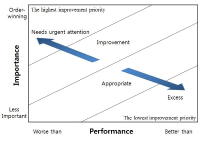


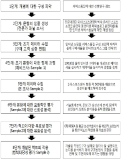
The purpose of this study was (a)to clearly define the concept of service quality as it relates to the online sports shopping mall, and (b)to develop and validate a psychometrically sound measurement scale, (c)examine the relationship among service quality and shopping satisfaction and intention of recommendation for marketing strategy internet sport shopping mall management. Following Churchill’s(1979) suggestions, the author developed internet Sports Shopping Mall Service Quality(E-SSMSQ). For the development E-SSMSQ (1)literature review, (2)focus group interview, (3)in-depth interviews (4)pilot test(n=97), (5)first data collected(n=459), (6)Frequency analysis, descriptive analysis, exploratory factor analysis(EFA) and reliability analysis for items evaluation, (7)confirmatory factor analysis(CFA) and correlation analysis for scale validation, (8)CFA, correlation analysis and structural equation model(SEM) test for predictive validity used second data collected(n=471). The current study conceptualized the service quality in the context E-SSMSQ by incorporating interaction, efficiency, order processing, information, security, and design. The authors also developed 20 items E-SSMSQ. The results of SEM support the psychometric property of the scale. First, interaction, efficiency and order processing of E-SSMSQ had significantly influence on internet shopping mall satisfaction. Interaction, efficiency, security, and design of E-SSMSQ had significantly influence on internet shopping mall intention of recommendation.

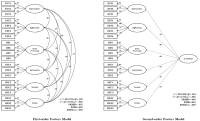

Purpose The purpose of this study was to empirically analyze the relationship between a commercial sports centers employees’ empathy, job satisfaction, customer orientation, service quality & organization loyalty through structural equation model analysis. Methods For this purpose, this study set 205 employees’ at the eleven commercial sports centers located in Seoul as the research subjects. In an effort to verify the proposed structural model, this study used IBM SPSSWIN Ver. 21.0 and AMOS 18.0. Results First, cognitive empathy had a positive effect on job satisfaction. Second, emotional empathy had a positive effect on job satisfaction. Third, communication empathy had a positive effect on job satisfaction. Fourth, job satisfaction had a positive effect on customer orientation. Fifth, job satisfaction had a positive effect on service quality. Sixth, job satisfaction had a positive effect on organization loyalty. Seventh, customer orientation didn’t had a positive effect on organization loyalty. eighth, service quality had a positive effect on organization loyalty.


Purpose This study aimed to investigate the impact of perceived service quality on satisfaction, and behavioral intention in migrant members of German sport clubs. Methods The questionnaire was structured in four sections: perceived service quality (four dimensions and 12 items), satisfaction (two items), and behavioral intention (two items). With data from 438 members of 33 sport clubs in western Germany, SPSS 23.0 and AMOS 23.0 were utilized to conduct factor analysis, reliability, validity, and structural equation modeling analysis. Results The results of this study indicated that (1) staff, sport program, interaction, and physical environment in perceived service quality had a significantly influence on satisfaction, (2) staff, sport program, and interaction significantly affected behavioral intention, and (3) satisfaction was found to have significantly impact on behavioral intention. Conclusions The delivery of high-quality services can promote satisfaction, which in turn lead to behavioral intention. The empirical results suggest that the practitioners and sport club mangers should understand the importance of perceived service quality for the retention of members in sport clubs.

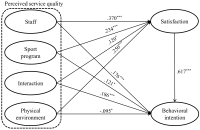

[Purpose] The purpose of this research is to empirically analyze the relationship between self-determination and relationship commitment, customer orientation, service quality, and relation continuity intention of fitness center customers through structural equation model analysis. [Methods] For this purpose, this study set 242 members at the five fitness centers located in Seoul as the research subjects. In an effort to verify the proposed structural model, this study used IBM SPSSWIN Ver. 21.0 and AMOS 18.0. [Results] As a result, first, autonomy had a positive effect on relationship commitment. Second, competence didn’t had a positive effect on relationship commitment. Third, relatedness had a positive effect on relationship commitment. Fourth, relationship commitment had a positive effect on customer orientation. Fifth, relationship commitment had a positive effect on service quality. Sixth, customer orientation had a positive effect on relation continuity intention. Seventh, service quality had a positive effect on relation continuity intention


Purpose This research was to empirically analyze the relationship between a commercial sports center customer-perceived employees' emotion labor (deep acting, surface acting) and sports center emotion, service quality & relationship retention through structural equation model analysis. Methods For this purpose, this study set 270 members at the two commercial sports centers(facilities equipped with more than 3 events) located in Suwon as the research subjects. In an effort to verify the proposed structural model, this study used SPSSWIN Ver. 21.0 and AMOS 18.0. Results first, this study found that deep acting had a positive effect on positive emotion. Second, it was found that surface acting had a positive effect on negative emotion. Third, deep acting was found to have a positive effect on service quality. Fourth, surface acting was found to have a negative effect on service quality. Fifth, the results showed that positive emotion didn't have a positive effect on relationship retention. Sixth, negative emotion was found to have a negative effect on relationship retention. Seventh, service quality was found to have a positive effect on relationship retention. Conclusion This findings indicate that the management of emotional labor is critical from the aspects of personnel management in sport centers.


Purpose This study attempted to investigate the difference on job satisfaction and service quality between non-regular and regular workers in commercial sports facilities. Methods With the purpose of the study, the purposive sampling as the non-probability sampling method was used to intentionally select the representative cases. We conducted through utilizing in-depth interviews with 6 non-regular and regular workers, respectively, who have worked for more than a year at total commercial sports facilities holding more than 3 programs with more than 500 memberships. This study aimed to explain real phenomena as much as possible by utilizing NVivo 11, one of qualitative research method programs, on the basis of raw data. Results In conclusion, non-regular and regular employment types in commercial sports facilities did not affect service quality provided for customers. However, it was derived that there was a slight difference between regular and non-regular workers on job satisfaction. Conclusion It is necessary to improve the wage and compensation system for regular workers as well as the labor policy to improve treatment of the wage according to the qualification of non-regular workers in commercial sports facilities. In spite of the instability of non-regular workers, the effort of converting into regular workers would evoke organizational commitment, loyalty, and attachment of non-regular workers, when properly acknowledged.






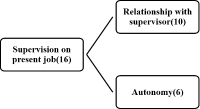










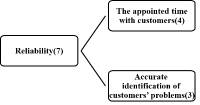





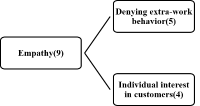

The purpose of this study was to examine the relationship among service quality, psychological experiment, and positive feedback including the moderating effect of motivation at Formula One World Championship. Therefore, the proposed research model was divided and compared by the level of motivation. By using questionnaire method, we found the following results. First, high motivation group indicated a higher-level of service quality, psychological experiment, and positive feedback than low motivation group's. Second, service quality had an influence on positive feedback directly and indirectly with the psychological experiment as a mediator. Third, it would be more effective for high motivation group that driving positive feedback through promotion while both promotion and watch is effective for low motivation group to drive positive feedback. Thus, promotion is considered as an important factor in both high and low motivation group and the watch needs to be strengthened in high motivation group.


Purpose The purpose of this study is to empirically inquire into the relationship between a commercial sports center employee's humor orientation & customer orientation and employees' trust, service quality, sports center relationship quality and relationship retention through structural equation model analysis. Methods For this purpose, the survey targeted 224 adult men and women who have used any one of the three commercial sports centers in Chungcheong for over three months. For sampling method, convenience sampling method was used, while the questionnaire was self-administered. In an effort to verify the proposed structural model, this study used IBM SPSSWIN Ver. 21.0 and AMOS 18.0. Results First, humor orientation was found to have a positive influence on employees' trust. Second, customer orientation was found to have a positive influence on employees' trust. Third, employees' trust was found to have a positive influence on service quality. Fourth, employees' trust was found not to have a positive influence on sports center relationship quality. Fifth, employees' trust was also found not to have a positive influence on relationship retention. Sixth, service quality was found to have a positive influence on sports center relationship quality. Seventh, service quality was also found not to have a positive influence on relationship retention.


Purpose The purpose of this research is to empirically analyze the relationship between a indoor swimming pool on service quality and involvement, place attachment, place attitude & relationship continuity intention through structural equation model analysis. Methods For this purpose, this study set 241 members at the five private indoor swimming pools located in Seoul as the research subjects. In an effort to verify the proposed structural model, this study used IBM SPSS WIN Ver. 21.0 and AMOS 18.0. Results As a result, First, the results showed that service quality had a positive effect on place identity. Second, it was found that service quality had a positive effect on place dependence. Third, the results showed that involvement didn't have a positive effect on place identity. Fourth, involvement didn’t have a positive effect on place dependence. Fifth, the results showed that place identity had a positive effect on place attitude. Sixth, the results showed that place dependence had a positive effect on place attitude. Seventh, place attitude was found to had a positive effect on relationship continuity intention.
